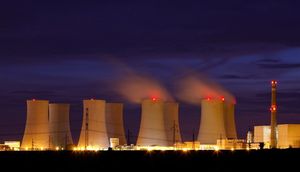
EVANSTON, IL – November 10, 2025 – Northwestern University today announced it has been awarded a substantial $2.7 million by the U.S. Department of Energy (DOE) Advanced Research Projects Agency-Energy (ARPA-E) for the development of its innovative microbial wastewater resource recovery technology. This significant funding, granted under ARPA-E's Realize Energy-rich Compound Opportunities Valorizing Extraction from Refuse waters (RECOVER) program, marks a pivotal moment in transforming wastewater treatment from a costly disposal challenge into a vital source of domestic resources. The N-PRIME system, as it is known, promises not only profound environmental benefits by mitigating nutrient pollution but also a strategic shift towards national energy and economic security by reducing reliance on imported fertilizers and critical materials.
N-PRIME: Engineering Nature for a Sustainable Future
The Northwestern-led project, officially titled "Nitrogen and Phosphorus Recovery via Intensified Microbial Extraction (N-PRIME): A Biotechnological Approach for Valorization of Municipal Wastewater," is spearheaded by a collaborative team of Northwestern Engineering researchers, including Professor George Wells (Civil and Environmental Engineering), Associate Professor Keith Tyo (Chemical and Biological Engineering), and Professor Jennifer Dunn (Chemical and Biological Engineering). The team also includes partners from the University of Minnesota, Current Innovation NFP, and Hazen and Sawyer.
At its core, N-PRIME utilizes engineered microbial systems – specifically, "self-replicating, self-assembling, and self-repairing bacteria" – to selectively concentrate and capture nitrogen and phosphorus from wastewater streams. Unlike conventional wastewater treatment that primarily focuses on removing pollutants, N-PRIME aims to recover these essential nutrients as high-value amino acids and marketable fertilizer products. This biotechnological marvel is designed for continuous recovery at greater productivity and lower cost than current state-of-the-art methods. While conventional biological nitrogen removal often involves energy-intensive nitrification and denitrification, N-PRIME seeks to efficiently capture nitrogen compounds before they are converted to atmospheric nitrogen, concentrating them for reuse. Similarly, for phosphorus, it likely leverages enhanced biological phosphorus accumulation processes, facilitating easier extraction of the concentrated nutrient.
This approach represents a fundamental departure from traditional "once-through" wastewater management, which typically treats wastewater as a waste product. Instead, N-PRIME champions a circular economy model, where "old resources are turned into new resources by recycling." Initial reactions from the environmental engineering and biotechnology communities are highly positive, recognizing N-PRIME as a forward-thinking solution that aligns with global sustainability goals. The project's academic and industry partnerships underscore its scientific rigor and potential for practical, scalable implementation, addressing limitations such as high costs, energy consumption, and sludge generation associated with conventional methods.
Market Implications and the Rise of Resource Recovery
The successful development and scaling of technologies like N-PRIME hold significant competitive implications across several sectors. Wastewater treatment plants and municipal utilities stand to benefit directly by transforming operational costs into potential revenue streams from the sale of recovered nutrients and amino acids. Major wastewater treatment companies like Veolia (EPA: VEOEY) and Suez (EPA: SZEVY) could integrate N-PRIME into their offerings, enhancing their sustainability profiles and providing more cost-effective services. Conversely, companies slow to adopt such innovations risk falling behind.
Fertilizer producers, including global giants like Nutrien (NYSE: NTR) and Mosaic (NYSE: MOS), could find new, domestic supply chains for nitrogen and phosphorus, reducing their reliance on imported raw materials and mitigating exposure to volatile global markets. This could disrupt established supply chains that rely on energy-intensive industrial processes for synthetic fertilizer production. Environmental technology companies and startups in the "climate-tech" and "circular economy" spaces are also poised for growth, with new opportunities for innovation, investment, and market entry by offering sustainable solutions. The recovery of high-value amino acids also implies benefits for companies in the specialty chemical and biochemical industries.
N-PRIME's potential to provide domestic sources of critical materials could significantly disrupt existing import/export markets for nutrients, strengthening national energy and economic security. Early adopters and developers will gain a first-mover advantage, establishing technological leadership and enhancing brand differentiation as pioneers in sustainable resource management. They can position themselves as sustainability leaders and cost-efficiency innovators, attracting environmentally conscious investors and customers while potentially benefiting from government incentives for sustainable resource recovery.
A Wider Lens: Sustainability, Smart Systems, and the AI Nexus
N-PRIME is a powerful example of how scientific innovation is driving the broader landscape of sustainable technologies and the circular economy. By transforming waste valorization, it directly addresses critical environmental concerns such as nutrient pollution, which causes algal blooms and oxygen depletion in aquatic ecosystems, and the generation of nitrous oxide, a potent greenhouse gas, from traditional treatment processes. Economically, it promises reduced operational costs for wastewater treatment and new revenue streams from valuable byproducts, enhancing economic security by reducing reliance on imported resources. Societally, it contributes to public health by improving water quality and promoting a healthier environment.
However, challenges remain for widespread adoption, including the technological and biological complexity of managing dynamic microbial communities, the need for robust regulatory frameworks, and substantial investment.
While the core N-PRIME technology is biological, its development, optimization, and future deployment are ripe for integration with the broader Artificial Intelligence (AI) landscape. Complex microbial systems like N-PRIME generate vast amounts of operational data, from influent composition to microbial community structure and product yield. AI and machine learning (ML) are indispensable for analyzing this data to:
- Predictive Performance: Monitor and predict system performance, detect anomalies, and anticipate suboptimal conditions in real-time.
- Process Optimization: Continuously learn and adapt operational parameters (e.g., temperature, pH, flow rates) to maximize nutrient recovery efficiency, product quality, and energy savings.
- Microbial Dynamics: Analyze complex multi-omics data (metagenomics, metatranscriptomics) to understand and manage microbial consortia, enabling better control and engineering of these biological systems.
AI can enable "smart control systems" for N-PRIME, automating adjustments based on incoming wastewater characteristics and desired output. This positions N-PRIME as a key component in the evolution towards "smart cities" and intelligent resource management infrastructure, where AI-driven insights ensure optimal resource allocation and environmental stewardship.
The Horizon: Adaptive Biorefineries and AI-Driven Sustainability
Looking ahead, the N-PRIME project is expected to contribute significantly to the long-term vision of transforming current wastewater treatment plants (WWTPs) into "adaptive, climate-conscious biorefineries." These future facilities will not only treat wastewater but also actively recover resources, mitigate ecological risks, and substantially reduce their carbon footprint. Potential applications on the horizon include enhanced nutrient recovery for domestic fertilizer production, bioenergy generation through anaerobic digestion or hydrothermal liquefaction, and even the production of biopolymers and bioplastics from wastewater.
Experts widely predict that AI and ML will be transformative tools in this evolution. AI-enhanced environmental DNA (eDNA) models are already achieving high predictive accuracy for effluent quality and the prevalence of antibiotic resistance genes, enabling near-real-time monitoring and adaptive control of treatment processes. This can lead to significant energy savings, particularly in aeration. The future envisions AI-driven "digital twins" of WWTPs, integrating molecular data with operational analytics to provide predictive microbiome management. This will allow operators to directly link microbial ecological signals with process optimization, public health risk mitigation, and climate-resilient infrastructure management.
Challenges for widespread adoption include the inherent complexity of microbial systems, the need for robust regulatory frameworks, and substantial investment. However, the integration of AI promises to overcome many of these hurdles by providing the intelligence needed to manage these complex biological systems efficiently and cost-effectively, accelerating the transition to a truly circular economy.
A Watershed Moment in AI-Enhanced Environmental Tech
Northwestern University's $2.7 million award for the N-PRIME technology is more than just a research grant; it's a profound investment in a sustainable future. This development underscores a critical shift in how we perceive and manage wastewater, moving from disposal to strategic resource recovery. The immediate significance lies in its potential to create secure domestic supply chains for essential nutrients, reduce environmental pollution, and foster economic value from what was once considered waste.
In the broader context of AI and technology, N-PRIME represents a compelling frontier where advanced biotechnology meets intelligent systems. While the core innovation is microbial, the ability of AI to analyze vast datasets, optimize complex biological processes, and enable autonomous control will be crucial for N-PRIME's scalability, efficiency, and long-term success. This synergy positions N-PRIME not just as an environmental breakthrough but as a significant milestone in the application of AI to solve real-world sustainability challenges.
In the coming weeks and months, industry watchers will be keen to observe the progress of the N-PRIME project, particularly its pilot-scale demonstrations and the refinement of its microbial engineering. Its success could catalyze further investment in similar resource recovery technologies and accelerate the integration of AI into environmental engineering, paving the way for a more resilient, resource-independent, and environmentally conscious society.
This content is intended for informational purposes only and represents analysis of current AI developments.
TokenRing AI delivers enterprise-grade solutions for multi-agent AI workflow orchestration, AI-powered development tools, and seamless remote collaboration platforms.
For more information, visit https://www.tokenring.ai/.





